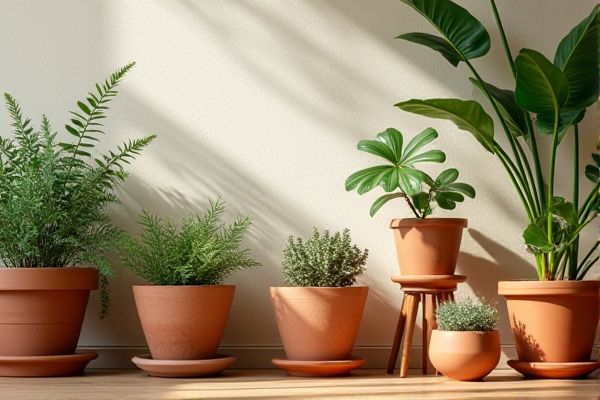
Clay pots offer superior breathability and natural insulation that promotes healthier root growth, while plastic pots are lightweight, retain moisture longer, and are more cost-effective for your gardening needs. Explore the full comparison to discover which pot material best suits your plants and preferences.
Table of Comparison
| Feature | Clay Pots | Plastic Pots |
|---|---|---|
| Material | Natural clay, porous | Polyethylene or polypropylene |
| Breathability | High, allows air and moisture flow | Low, less air circulation |
| Weight | Heavy, sturdy | Lightweight, portable |
| Durability | Fragile, can crack | Durable, resists breakage |
| Water Retention | Dries out faster | Retains moisture longer |
| Cost | Moderate, varies by size | Low to moderate |
| Environmental Impact | Eco-friendly, biodegradable | Non-biodegradable, recyclable |
| Ideal Usage | Best for plants needing well-drained soil | Suitable for moisture-loving plants |
Introduction to Clay Pots and Plastic Pots
Clay pots, made from natural terracotta, offer excellent breathability and moisture regulation for plant roots, promoting healthier growth. Plastic pots, crafted from durable polymers, are lightweight, widely available in various sizes and colors, and retain moisture longer, reducing the frequency of watering. Both pot types serve distinct gardening needs, with clay pots favored for aeration and plastic pots valued for convenience and water retention.
Material Composition and Durability
Clay pots are made from natural, porous earthenware that allows air and moisture to pass through, promoting healthier root systems but making them more fragile and prone to cracking under extreme temperatures. Plastic pots consist of synthetic polymers, offering high durability, resistance to weather conditions, and flexibility, making them less likely to break or crack. While clay pots provide better breathability for plants, plastic pots excel in longevity and impact resistance, influencing their suitability for different gardening needs.
Aesthetic Appeal and Design Options
Clay pots offer a natural, rustic aesthetic with earthy tones and textured surfaces that enhance garden beauty and blend seamlessly with outdoor landscapes. Plastic pots provide a wide range of vibrant colors, shapes, and modern designs, allowing for greater customization to fit diverse decor styles. Both materials serve different design needs, with clay pots favored for traditional elegance and plastic pots preferred for versatility and contemporary appeal.
Water Retention and Drainage Capabilities
Clay pots offer superior breathability with porous walls that enhance water evaporation and promote air circulation, reducing the risk of root rot by preventing waterlogging. Plastic pots, with non-porous surfaces, retain moisture longer, making them ideal for plants that require consistent hydration but increase the risk of overwatering without adequate drainage holes. Effective water retention and drainage depend on the specific needs of the plant species and environmental conditions, influencing growth and root health.
Breathability and Root Health
Clay pots offer superior breathability due to their porous nature, allowing air and moisture to circulate freely around the roots, which promotes healthier root systems and reduces the risk of root rot. Plastic pots, while lightweight and retaining moisture longer, can restrict airflow and lead to waterlogged soil, potentially harming root health. Choosing clay pots enhances your plant's oxygen access and prevents overwatering issues, supporting optimal growth.
Weight and Portability
Clay pots are significantly heavier than plastic pots, making them less portable and more challenging to move, especially when filled with soil and plants. Plastic pots offer lightweight durability, allowing you to easily relocate your plants for optimal sunlight or seasonal changes. Your choice between the two should consider how often you need to move your plants and the convenience of handling.
Cost and Availability
Clay pots generally have a higher initial cost than plastic pots, as they require more materials and manufacturing processes. Plastic pots are widely available in various sizes and styles at affordable prices, making them accessible for most gardening needs. Your choice may depend on budget constraints and convenience, with plastic pots offering cost-effectiveness and easy replacement.
Environmental Impact and Sustainability
Clay pots are biodegradable and made from natural materials, reducing environmental pollution and promoting sustainability. Plastic pots contribute significantly to landfill waste and often require fossil fuels for production, leading to higher carbon emissions. Choosing clay pots supports eco-friendly gardening by minimizing non-biodegradable waste and encouraging the use of renewable resources.
Suitability for Indoor and Outdoor Use
Clay pots offer excellent breathability, making them ideal for outdoor use where plants benefit from better air circulation and moisture regulation. Plastic pots are lightweight and retain moisture longer, which suits indoor environments with less airflow and consistent watering needs. Your choice depends on whether you prioritize natural aeration outdoors or convenience and moisture retention indoors.
Final Comparison: Which Pot is Best for Your Plants?
Clay pots offer superior breathability and natural temperature regulation, promoting healthier root systems and reducing the risk of overwatering. Plastic pots retain moisture longer and are lightweight, making them ideal for indoor plants and easy mobility. Choosing the best pot depends on your plant's water needs, environmental conditions, and how often you can monitor watering.
 homyna.com
homyna.com